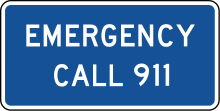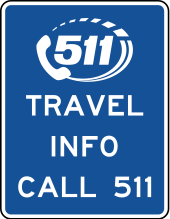N11 code

An N11 code ("N-one-one" code) or N11 number is a three-digit abbreviated dialing telephone number within the North American Numbering Plan (NANP) which allows access to specific local services.
Usage is generally assigned as follows:

- 2-1-1: Community services and information (i.e. United Way of America)
- 3-1-1: Municipal government services, non-emergency number
- 4-1-1: Directory assistance; exception is Texas, most of which requires 1+4-1-1
- 5-1-1: Traffic information or police non-emergency services
- 6-1-1: telephone company (telco) customer service and repair
- 7-1-1: TDD relay for the Deaf and Hard of Hearing
- 8-1-1: Underground public utility location,[1] in Canada 8-1-1 is assigned for non-emergency health information and services
- 9-1-1: Emergency services (police, fire, ambulance/rescue services)
Each of these eight numbers is part of a dial plan that prevents 10,000 telephone numbers (from N11-0000 to N11-9999) from being assigned. Only non-geographic area codes, such as toll-free 800/888/877/866/855/844 numbers, area code 600 and area code 900 may use N11 as the telephone exchange prefix, since there is no local calling from these area codes. Even there, the ban against issuing 9-1-1 as an area code or exchange prefix remains absolute.
Service
9-1-1 and 4-1-1 work from nearly every telephone in the U.S. and Canada, while the availability of the other N11 codes varies by location. 9-1-1 access is mandated by law, even on lines with no service (a "soft" dial tone). 6-1-1 (formerly 8-1-1) may also be accessible to activate service on such lines, and 3-1-1 may be available as well for urgent (but non-emergency) calls to police, or any call to local government in some places. Generally, only 4-1-1 calls incur a fee.
Other community services are provided through 2-1-1, but only if a non-profit organization such as the United Way operates it locally. Likewise, local or state/provincial government may or may not operate traffic information through 5-1-1. 8-1-1 was made mandatory in the U.S. in 2007, as is 7-1-1. Unlike 9-1-1, these may or may not be available on a phone without paid service.
0-1-1
0-1-1 followed by a country code is used to dial internationally, but this use is not considered an N11 code. 1-1-1 is not available in the NANP, because 11 is the prefix used to access vertical service codes from rotary phones, and is essentially meaningless to the system otherwise.
See also
- Single Non-Emergency Number, used in the United Kingdom
References
- ↑ See FCC Doc. No. 92-105
External links
- FAQ on Use of N11 Service Codes from USA.gov
- N11 Codes Assignment from NANPA.com
- Administered N11 Codes in Canada from Canadian Numbering Administration Consortium